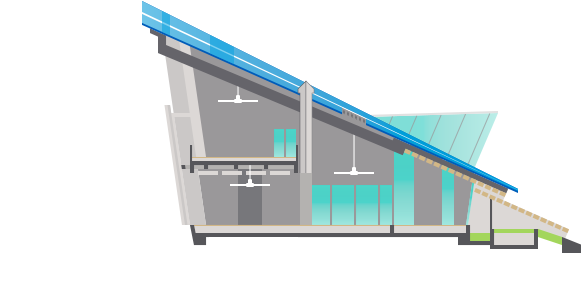All Sections
Sustainable Site Planning Strategy
Zero Carbon Design Strategy
Building Materials Strategy
On ZCB's inclined main roof, Polycrystalline Silicon PV panels are installed. They function best for the inclined angle of 17 to 20 degrees with higher levels of direct solar radiation.
Polycrystalline Silicone PV panels are installed on ZCB's inclined main roof.
Building Integrated Photovoltaics (BIPV) are used for the roof of the viewing deck.
Cylindrical CIGS are integrated in the Air-Tree installation to capture direct, diffused and reflected sunlight.

Any opinions, findings, conclusions or recommendations expressed in this material/event do not necessarily reflect the views of the Government of the Hong Kong Special Administrative Region, the Environment and Conservation Fund and the Environmental Campaign Committee.
ZCB is the first Zero Carbon Building in Hong Kong with energy plus status and net zero carbon emissions on an annual basis. It was developed by the Construction Industry Council to showcase state-of-the-art low carbon building design and technologies to the industry locally and internationally, and to raise community awareness of low carbon living in Hong Kong.
In recent years, environmental problems like global warming and resource scarcity have become important issues and energy conservation plays an important role in alleviating these problems. Through integrated passive building design and energy efficient active systems, ZCB minimizes energy consumption and demonstrates the balance between nature and the built environment.
ZCB also generates on-site renewable energy from photovoltaic panels and a tri-generation system using biofuel made of waste cooking oil to meet its energy consumption needs.. Beyond this, ZCB exports surplus energy to offset the embodied carbon from its construction process and major structural materials. ZCB is the blueprint for promoting the adoption of low carbon design strategies and technologies for future buildings.
On the Air-Tree covered walkway system, the highly efficient, cylindrical CIGS thin-film PV technology is used for its pioneering installation in Hong Kong. Besides direct and diffused sunlight, the solar cells on the cylindrical tube also capture sunlight reflected from the ground or roof, which is normally wasted in panel-type installations.
Building Integrated Photovoltaics (BIPV) are used for the roof of the viewing deck, where shading and daylighting are to be optimized.